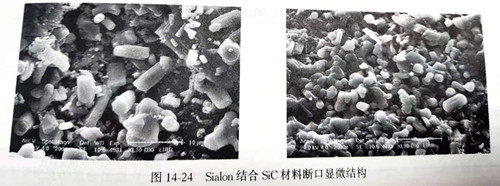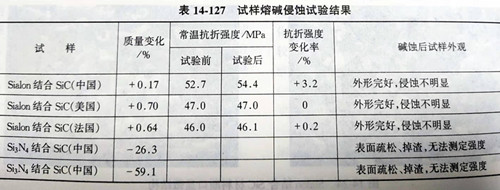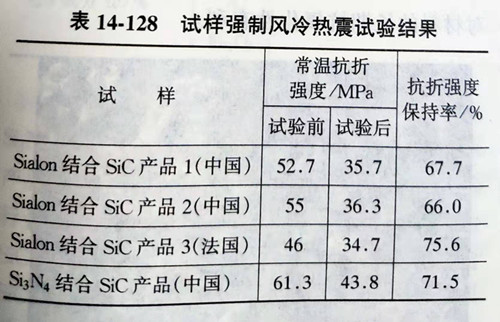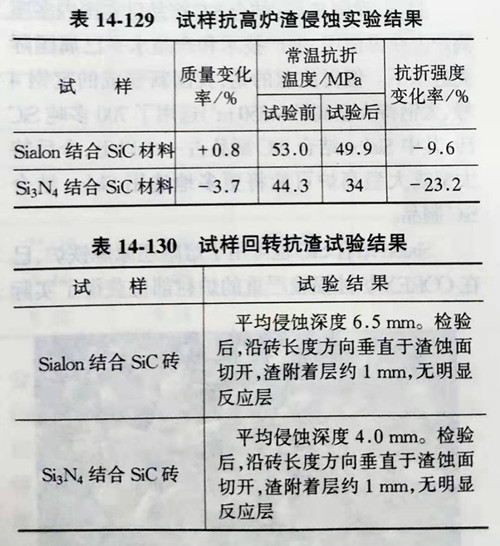Sialon Bonded SiC
Sharon (Sialon) is composed of Si, Al, O, N elements such as compound floorboard, including β-Sialon, ɑ-Sialon, O- Sialon, containing Si, O elements of AlN type body, etc. Among refractory materials, Sialon and o-sialon have been used in industrial applications. Sialon bonded SiC products now commonly refer to Sialon bonded SiC materials. Si-sialon is a solid solution in si-si3n4 partially replaced by al-o bond. In the si-al-o-n quaternary characteristic phase diagram, the composition of -sialon extends from Si3N4 as the starting point to 4/3aln ·Al2O3, and the composition changes in a considerable range. Its chemical formula is si6-zalzozn8-z, z =0~4.2. O-sialon is the solid solution of Si2N2O. The chemical formula is si2-x-zalxo1 + xn2-x, x =0~0.2. The crystal lattice constant of si-sialon is larger than that of si-si3n4, and the crystal is columnar, generally larger than that of si-si3n4. D-sialon has excellent properties of si3n4-based ceramic materials, such as high hardness, excellent mechanical properties, corrosion resistance, thermal shock resistance, linear expansion coefficient, slightly lower than d-si3n4 ((2~3) ×10-6℃-1), thermal conductivity is lower than d-si3n4, and d-sialon strength generally decreases with the increase of Z value. Compared with Si3N4, si-sialon has better oxidation resistance and stronger corrosion resistance to molten liquids and alkali such as Al, Fe and Zn. Sialon bonded SiC products are mainly prepared by reaction sintering. The nitriding sintering temperature is usually higher than that of Si3N4 bonded SiC products, and the comprehensive production cost is slightly higher than that of Si3N4 bonded SiC products. So far, Sialon combined with SiC has been used successfully in many blast furnace hearth and hearth positions at home and abroad, and is considered as the second generation of blast furnace SiC bricks. Sialon combined SiC materials for blast furnace have been studied extensively at home and abroad. Luoyang refractories research institute was the first to develop successful Sialon combined SiC products in China and made a systematic and in-depth study on their performance.
The primary crystal phase of Sialon bonded SiC material is SiC, and the secondary crystal phase is si-sialon. A small amount of residual Al2O3 and 15R phase can be found in some products. In terms of microstructure, Sialon bonding SiC and Si3N4 bonding SiC are quite different. Figure 14-24 shows the typical SEM photos of fracture microstructure of Sialon bonding SiC material (taken from products of luoyang refractories research institute). The bonding Sialon is mainly columnar or short-columnar, and the columnar Sialon forming network closely binds SiC particles. In the combination of Si3N4 with SiC materials, Si3N4 is mainly fibrous crystals. These crystals have large specific surface area and high surface activity, and their oxidation resistance will not be as stable as columnar crystals in oxidizing atmosphere. Sialon and Si3N4 have different properties due to their different microstructure combined with SiC materials. Physical and chemical properties of Sialon combined with SiC products are shown in table 14-124. Compared with Si3N4 combined with SiC products, their physical properties are similar, and it is difficult to distinguish these two materials from conventional physical indicators. In terms of chemical composition, Sialon bound SiC contains more Al2O3, while Si3N4 bound SiC products contain very low content of A2O3.

For SiC products used in blast furnace, the content of SiC is generally 70%~80%. Under the condition of the same or similar SiC, the linear expansion coefficient of Sialon bonded SiC is slightly higher than that of Si3N4 bonded SiC (see figure 14-21) and the thermal conductivity is slightly lower.
Sialon bonded SiC material has excellent mechanical and mechanical properties at room temperature and high temperature. The flexural strength at 1400℃ of most products is higher than that at room temperature, which is the same as that of Si3N4 bonded SiC material.
Sialon bonded SiC material has excellent alkali resistance. It can be seen from table 14-126 that both Sialon and Si3N4 combined with SiC materials have excellent alkali erosion resistance, but it is difficult to intuitively judge the strength of their alkali erosion resistance from the experimental data. Table 14-126 shows the test results of the alkali corrosion resistance of Sialon and Si3N4 combined with SiC. The GB/ t14983-1994 method was adopted, and the erosion time was 3 h. Both Sialon and Si3N4 combined with SiC had excellent alkali corrosion resistance.

Hoogovens, a Dutch company, has developed a test method to test the alkali resistance of materials. The test method is as follows: sample 120mmX25mmX20mm was placed in K2CO3 solution with a concentration of 4 M under vacuum. After the sample was dried, the strength and strength change rate of the sample after soaking K2CO3 were determined. At the same time, the original brick and the impregnated sample were calcined at 800℃, 1000℃ and 1200℃ in oxidizing atmosphere for 16 h, respectively, and the relative strength of the two samples was measured. The alkali-corrosion resistance of the samples was measured by the change rate of the strength of the samples. The results showed that there was no significant difference in strength reduction of qualified Sialon, Si3N4 and nh-sic combined with SiC products after alkali corrosion. The alkali corrosion resistance of materials is one of the most important parameters to predict the life of blast furnace. The GB/ t14983-1994 standard in China and the method of hogoven company cannot clearly distinguish the advantages and disadvantages of Sialon and Si3N4 combined SiC materials and alkali corrosion resistance.
The experimental method of molten alkali erosion was first developed and applied in luoyang refractory research institute of China iron & steel group. The test method is as follows: 125 nmm1X 25mmX25mm samples were placed in a stainless steel box, buried with pure anhydrous K2CO3, covered and then buried with coke particles, calcined at 930℃ for 3 h, cooled to room temperature, and repeated for 1 time. After erosion, the samples were washed and dried, and their mass changes and bending strength at room temperature were measured. Table 14-127 shows the molten alkali erosion test results of different products. Sialon combined with SiC samples after molten alkali erosion, the shape of the samples remained intact, and the flexural strength did not change much. However, Si3N4 combined with SiC is eroded by molten alkali, the weight loss is up to 15% ~ 60%, and the corrosion is serious. The resistance of Sialon to alkali erosion is obviously better than that of Si3N4 to alkali erosion. Sialon to SiC is more suitable for severe alkali erosion in blast furnace.

In the newly formulated "cylon bonded refractory products" industry standard, the anti-molten alkali index (reference index) is set in the technical index requirements of Sialon bonded SiC bricks. The anti-molten alkali detection method can intuitively distinguish Sialon and Si3N4 bonded SiC materials, and can also detect product quality according to this.
Sialon combined with SiC has excellent oxidation resistance. The samples of Sialon and Si3N4 were placed in an electric furnace with muffle plate, and steam was injected at 1150℃ for 100 h heat preservation. After the test, the mass change rate of Sialon bound SiC samples was +2.54%, and that of Si3N4 bound SiC was + 3.12%. The water vapor oxidation resistance of Sialon bound SiC was slightly better than that of Si3N4 bound SiC.
Sialon combined with SiC material has excellent thermal shock resistance. Table 14-128 shows the test results of the sample forced wind cold and hot shock, and the test method is consistent with table 14-120. After thermal shock, the flexural strength of the samples is around 35 MPa, and the strength retention rate is above 60%, slightly lower than that of Si3N4 bonded SiC materials, and the thermal shock resistance of Sialon bonded SiC products is slightly lower than that of Si3N4 bonded SiC. Sialon combined with SiC material has excellent resistance to blast furnace slag erosion. Table 14-129 compares the test results of Sialon and Si3N4 combined with SiC under the condition of high titanium blast furnace slag erosion, and the test method is consistent with table 14-121. After slag erosion, Sialon bonded SiC material has small mass change, high residual strength and small strength reduction, indicating that Sialon bonded SiC material has better corrosion resistance under this slag erosion condition. Table 14-130 shows the test results of the rotary slag resistance of the sample. GB/T 8931-1988 method was adopted to test the conditions at 1500℃ for 10 h. The experimental slag was furnace slag (SiO2 32.89,Fe2O3 0.32,Al2O3 15.38,Ca2O3 5.74,MgO 8.51, K2O 0.18, and Na2O 0.36). In this slag erosion condition, both kinds of bricks show excellent slag erosion resistance, and Si3N4 combined with SiC material brick has better slag erosion resistance. Under different slag erosion conditions, both Sialon and Si3N4 combined with SiC showed excellent slag erosion resistance. The research shows that Ti(C,N) will be formed in the material when TiO2 exists in the blast furnace slag, and it will be accumulated in the working layer to prevent further invasion of slag, which can effectively extend the service life of SiC materials. For blast furnace slag, the static crucible experiments on slag erosion resistance show that the slag corrosion resistance of pure Sialon material is worse than that of pure Si3N4. With the increase of Z value, the slag corrosion resistance decreases. When the z-value of Sialon is greater than 3, the slag corrosion resistance of Sialon material significantly decreases.


In general, compared with Si3N4 bonded SiC materials, the advantages of Sialon bonded SiC mainly lie in better alkali resistance and better corrosion resistance of molten iron and aluminum.
The Z value of Sialon has an effect on the properties of Sialon bonded SiC materials. For this research, different researchers have different views. Some Japanese scholars believe that when Z=2, the strength at room temperature and high temperature is the maximum, and the thermal shock resistance is the same as the Z value
The alkali resistance and slag resistance decreased with the increase of Z value. The larger the Z value, the larger the volume expansion after alkali treatment. Sialon produced by Savioe company of France is combined with Z=3 of SiC brick (SicanitAL3), and the practical application effect is good. The earliest Sialon combined SiC bricks produced and successfully applied in China,Z=2~3. The tests of pure dann-sialon material showed that dann-sialon material with Z=0.5~ 4.0 had good corrosion resistance to molten alkali, which was obviously better than Si3N4 material, and was optimal when Z=1.5~2.5. In the actual selection of materials, how much Z value to choose the best, the current research is not in-depth enough, mainly based on the practical application of experience to determine the effect. The energy spectrum analysis of the product shows that the measured Z value is the average value, and the Z value of different parts of the product fluctuates around the average value. For different blast furnace conditions, the Z value may be slightly different. The author thinks that choosing Z=1.5~3.0 can produce products with excellent performance, which can meet the actual use of blast furnace, and the Z value of Sialon combined with SiC products should be chosen between 2~ 3.
At present, our country's Salon combined with SiC products has been used in many domestic blast furnaces, and the production technology and product level have reached the international advanced level. It is worth noting that China's newly built baosteel no.4 and tisco extra-large blast furnaces (4350m3) used more than 700 tons of SiC bricks, of which Sialon combined SiC products accounted for more than half. In the future, extra-large or large blast furnaces may use more Sialon combined SiC products.
Sialon combined with SiC can also be used in melting reduction ironmaking furnaces
Application, related to this aspect of the research and in-depth reports are still few.
Sialon combined with SiC has been applied in non-ferrous metal industry such as zinc smelting. Practice shows that Sialon, Si3N4, combined with SiC and oxide combined with SiC have a good use effect, but if the cost performance of the product is measured,Sialon combined with SiC is not competitive, the use of this aspect may gradually decrease, while the use of oxide combined with Si3N4 combined with SiC will increase.
In the kiln furniture industry, Sialon's mechanical properties and thermal shock resistance of SiC combined with Si3N4 are not superior to that of Si3N4 combined with SiC materials, and the cost of products is relatively high, which may not have a good development prospect as kiln furniture products.

